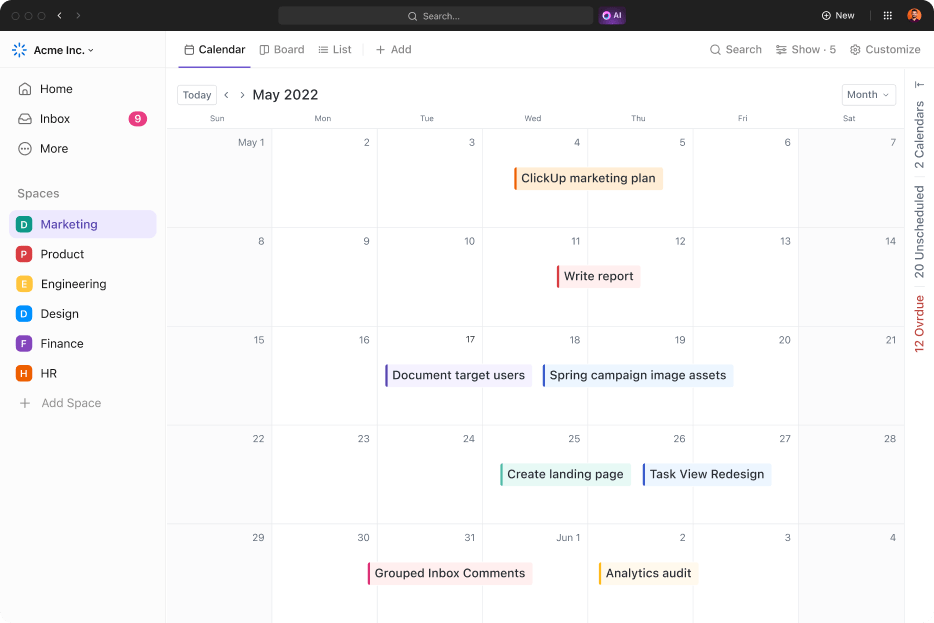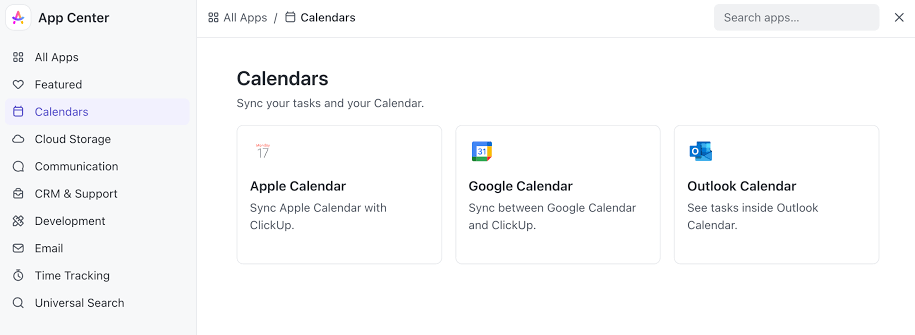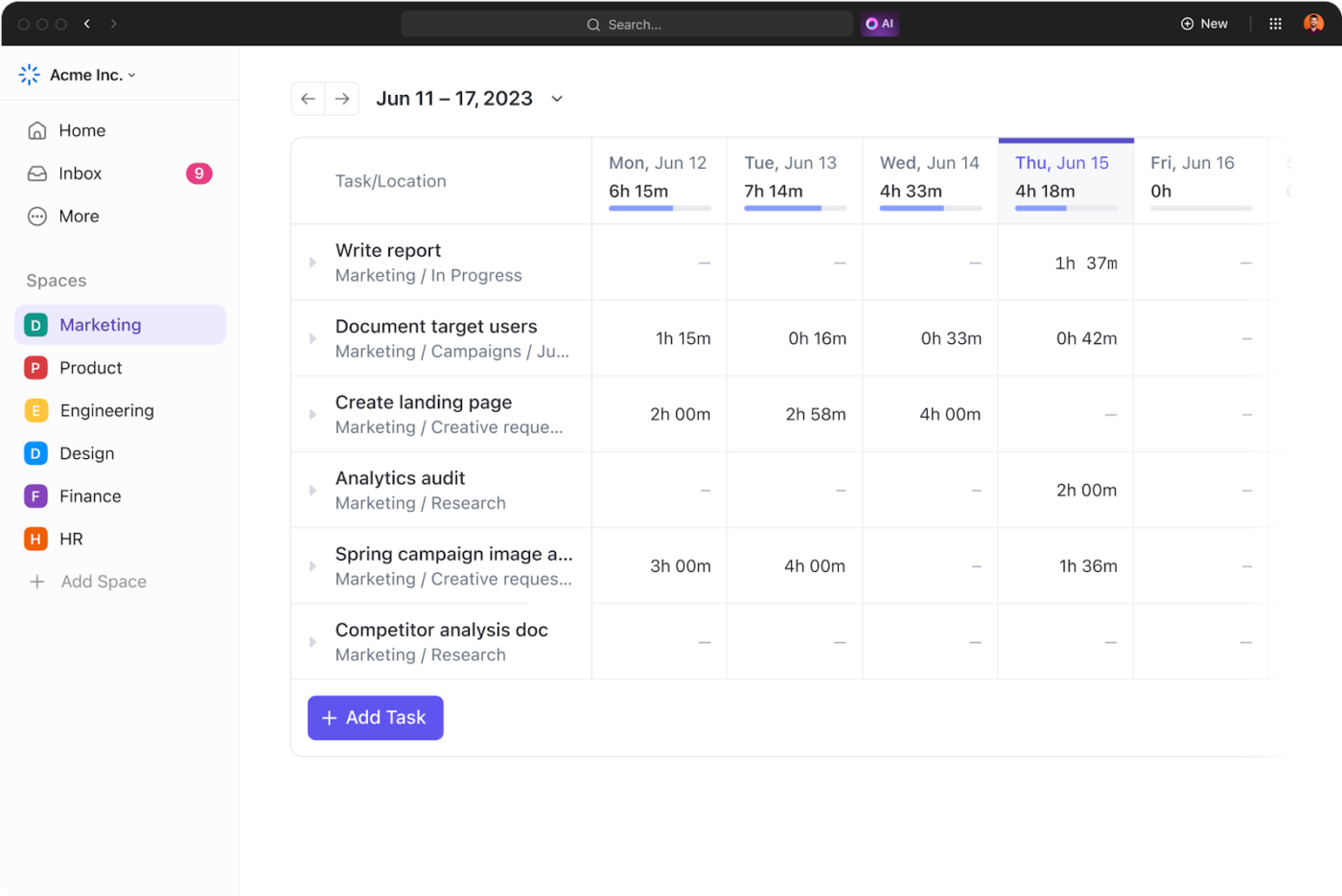Calendar Optimization: How to Maximize Productivity and Manage Time

Sorry, there were no results found for “”
Sorry, there were no results found for “”
Sorry, there were no results found for “”

Your calendar should help you stay organized, not overwhelm you. But when your days are filled with back-to-back meetings, unexpected tasks, and constant rescheduling, it’s easy to fall behind.
And finding time for focused work? Nearly impossible.
Calendar optimization focuses on making time for what actually matters. A few smart adjustments can help you take control of your schedule, protect your focus, and get more done without stretching too thin.
Let’s break down how to do it. ⚒️
A calendar should be your ally, not a puzzle you’re constantly solving. You lose time, momentum, focus, and work when it’s off-kilter.
Let’s change that.
Here are some sharp calendar optimization techniques and productivity hacks to fine-tune your days and amplify what drives you. 📝
A calendar packed with random meetings, overlapping deadlines, and zero breathing room leads to constant firefighting.
Time blocking helps you take charge of your schedule by dedicating specific slots for focused work, collaboration, and even buffer time.
✅ Try this: First, create recurring commitments—team meetings, reporting deadlines, and brainstorming sessions. Then, assign time blocks for deep work, admin tasks, and personal breaks. Keep similar tasks together so your brain doesn’t have to shift gears every five minutes.
📌 Example: A content manager working on multiple articles can block mornings for writing and afternoons for revisions and meetings. This prevents constant context switching and speeds up workflows.
Explained: Time blocking vs time boxing for calendar management
Time Blocking: Scheduling chunks of time for different types of work (e.g., “2-4 pm: deep work”).
Time Boxing: Setting a fixed time limit to complete a specific task, then stopping when time’s up, regardless of completion.
So, basically, time blocking organizes your schedule by themes, while time boxing constrains individual tasks with strict deadlines.
Not all hours in the day feel the same.
Some tasks require laser focus, while others can be tackled despite low energy. Aligning your project management calendar with your natural productivity rhythms helps you get more done without feeling drained.
✅ Try this: Pay attention to when you feel most alert during the day. Use high-energy hours for complex work and save routine tasks when your focus dips.
📌 Example: A product designer who’s most creative in the morning can schedule design work early in the day and leave email responses for later. This keeps the most demanding tasks from getting pushed aside.
Packing meetings back-to-back might look efficient on your calendar, but it’s a fast track to burnout. Rushing from one call to another leaves no time to process discussions, take notes, or even grab a coffee.
✅ Try this: Leave at least 10-15 minutes between meetings. Use this time to jot down action items, prep for the next discussion, or reset before diving back in.
📌 Example: A consultant moving between client calls can use short gaps to update project notes and follow up on key takeaways. This prevents essential details from being missed.
Balancing deadlines, meeting invites, and task lists manually can lead to overlooked priorities. Connecting your calendar with effective productivity tools automates scheduling, ensures alignment, and prevents double-booking mishaps.
✅ Try this: Connect your calendar to project management apps, email platforms, and online meeting tools. You can automate meeting invites, deadline reminders, and recurring tasks to reduce stress.
📌 Example: A project manager using ClickUp can link tasks to calendar events, making it easier to track deadlines, ensure meetings align with project timelines, and communicate across teams. No more flipping between tabs to see what’s due when.
Even the best schedule needs fine-tuning. A packed calendar that looked perfect on Monday might feel overwhelming by Wednesday.
Checking in on your schedule regularly helps you spot inefficiencies and tweak things before they become a problem.
✅ Try this: Spend 10 minutes at the end of each week reviewing what worked and what didn’t. If specific tasks keep getting pushed back or meetings consistently run over time, adjust your schedule to fix the bottlenecks.
📌 Example: A business owner noticing that admin work always spills into deep work hours can move those tasks to a less demanding time slot. This keeps high-priority work from being derailed.
💡 Pro Tip: Assign distinct colors to various types of activities or projects in your daily planner app. For example, use blue for client meetings, green for personal appointments, and red for deadlines. This visual differentiation allows you to assess your schedule and prioritize tasks effectively.
Managing a packed schedule often means juggling meetings, shifting deadlines, and finding time for focused work—all while trying to stay productive.
ClickUp simplifies this process. 🤩
It’s the everything app for work that combines project management, knowledge management, and chat—all powered by AI that helps you work faster and smarter. Its advanced calendar features simplify scheduling and automatically adjust to your priorities, ensuring you stay focused on what matters most.
Let’s explore how it helps optimize your calendar! 💁
Traditional calendars require constant updates. If a meeting runs over or an urgent task pops up, everything else gets pushed back, forcing you to reshuffle your schedule throughout the day.
ClickUp Calendar eliminates this problem, automatically blocking focus time, rescheduling tasks, and keeping meetings organized—all without manual effort.
This intelligent scheduling tool helps users manage tasks, meetings, and deadlines in one place. It syncs with Google Calendar and Microsoft Outlook, ensuring external commitments don’t overlap with internal work.
ClickUp Brain, the integrated AI assistant, continuously optimizes schedules based on deadlines, priorities, and availability.
Let’s say a marketing manager has planned a three-hour strategy session, but an urgent client meeting is added at the last minute. The AI calendar adjusts the schedule automatically, ensuring the session still happens without derailing the rest of the day.
💡Pro Tip: ClickUp’s AI Agents can automatically block focus time, reschedule meetings, send reminders, and update tasks based on your calendar activity. They work in the background to protect your deep work hours and keep your schedule running smoothly.
Learn to set up your own AI Agent in ClickUp:
🧠 Fun Fact: The ancient Egyptians were among the first to recognize that a year wasn’t exactly 365 days. They added five extra days to their calendar and even introduced the leap year concept way before Julius Caesar made it official.
Jumping between different apps to check meetings, deadlines, and tasks wastes time. ClickUp Calendar View combines everything, offering a centralized view of upcoming commitments.

You can switch between daily, weekly, or monthly views to get granular details.
A content manager, for example, can use the monthly view to plan a content calendar while team members focus on their daily tasks. Meetings sync automatically from Zoom, Google Meet, and Microsoft Teams, so no one has to hunt for links before a call when managing multiple calendars.
Don’t want to start from scratch? Turn to ClickUp Templates.
For structured planning, you can try the ClickUp Calendar Planner Template. It simplifies scheduling with pre-built structures that help you organize to-dos, events, tasks, and deadlines efficiently. Custom views, such as Summary, Progress Board, Timeline, and Monthly Planner, allow users to visualize their schedules effectively.
💡Pro Tip: Connect all your external calendars (Google, Outlook, Apple) to ClickUp. This way, you can see personal, team, and project events in one place—no more double-booking or missing important appointments. ClickUp’s two-way sync ensures updates in one calendar reflect everywhere, keeping your schedule accurate and up to date.

You can also filter your ClickUp Calendar by assignee, tag, priority, or custom fields. This helps you zero in on what matters most—like just your tasks, or only high-priority deadlines.
🧠 Fun Fact: Ever wondered why September, October, November, and December have names that mean seven, eight, nine, and ten? That’s because in the old Roman calendar, March was the first month, making these months the 7th, 8th, 9th, and 10th.
Logging hours shouldn’t feel like a chore. ClickUp Project Time Tracking keeps everything organized so teams can stay focused without worrying about how much time they spend on work.

Timers run directly inside tasks, automatically recording hours as work progresses.
For example, say a marketing agency is running an ad campaign for a client. The project manager assigns tasks to the team—one for ad copy, another for design, and another for performance tracking. The copywriter starts the timer when drafting the ad, the designer does the same while creating visuals, and the analyst tracks time spent reviewing campaign data.
At the end of the project, the manager generates a report showing exactly how much time each phase took, making it easy to bill the client accurately.

Forgot to track time? ClickUp lets users add entries afterward.
Time reports show managers exactly how hours are spent, helping them adjust workloads before things get overwhelming. If someone spends extra time on specific tasks, schedules can be tweaked to improve efficiency and prevent burnout.
📮 ClickUp Insight: 35% of knowledge workers report Monday as their least productive workday, often feeling overwhelmed by meetings and unfinished tasks.
ClickUp helps you plan smarter, block focus time, and start the week with clarity. With real-time updates and seamless integrations, your workflow is structured so you can start the week with clarity and stay productive throughout.
📖 Also Read: How to Automate Google Calendar Events

ClickUp Automations take care of task updates, reminders, and recurring schedules, so teams don’t have to.
Suppose a content team is managing blog posts. When a writer submits a draft, ClickUp automatically updates the task to ‘In Review’ and assigns it to an editor. No one has to move tasks manually. For deadlines, automated reminders ensure nothing gets delayed. ClickUp alerts the designer and notifies the project manager if a design task is due soon.
🔍 Did You Know? When Britain and its colonies finally switched from the Julian to the Gregorian calendar in 1752, they had to drop 11 days to correct for inaccuracies. People went to bed on September 2nd and woke up on September 14th. Some even thought their lives had been shortened.
🌟 AI Power-Up: Automate your scheduling workflow with ClickUp’s advanced AI features.
ClickUp Brain MAX can search across your meetings, tasks, and deadlines in seconds—no more digging through tabs or apps.
With Talk to Text, add events, set reminders, or update your schedule using just your voice, making it easy to stay organized even on the go.
Search, schedule, and optimize your calendar with a few clicks or voice commands!
Like any system, calendar organization comes with its own set of challenges. Let’s break down the pros and cons so you know what to expect. 👇
A well-structured calendar helps you:
💡 Pro Tip: Use the reverse calendar method to stay on track. Set your deadline, then work backward to map out key milestones. Breaking tasks into smaller steps with clear time slots keeps everything on schedule and avoids last-minute chaos.
However, even the best calendar system has obstacles. Here’s what to look out for:
💡Pro Tip: Download the ClickUp mobile app to manage your calendar on the go. Get push notifications for upcoming meetings, reschedule tasks, and track time from anywhere.
🤝 Friendly Reminder: The trick is to use calendar optimization as a guide, not a rigid rulebook. Small adjustments make a big difference, so focus on progress, not perfection.
Time is limited, but your control over it doesn’t have to be.
Calendar optimization helps you manage multiple calendars, focus on high-impact work, automate repetitive tasks, and stay one step ahead without overworking.
ClickUp, the everything app for work, makes time management easier than ever. With all the features you need, like AI calendars, time tracking, calendar views, linked tasks, AI assistance, and smart automations, you can align your tasks, to-do lists, and priorities—all in one place.
This converged AI workspace puts an end to the work sprawl teams increasingly face, working across multiple, disconnected tools, platforms, and systems that don’t talk to each other.
Want to make the most of your time? Sign up for ClickUp today! ✅
© 2025 ClickUp